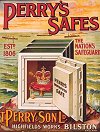 |
THOMAS PERRY AND SON LTD3. Company History - turn of the century - page 1 by Frank Sharman and Reg Aston |
|
 |
THOMAS PERRY AND SON LTD3. Company History - turn of the century - page 1 by Frank Sharman and Reg Aston |
|
At the end of the 19th century and the beginning of the 20th the company was a large, well established firm engaged in a range of heavy engineering activities.
This advertisement (from the Engineer) is dated 1893. The references to "rolling mill machinery for all kinds of metals" , to "chilled and grain rolls" and to "shearing machines for plates, blooms, &c" indicates that Perry's were, by now, well into the manufacture of all kinds of machinery needed for processing metals. But the references to "steam blowing and pumping engines" and to "machine made wheels" is the only reference we have to this company making these sorts of products; so how much of this sort of work they actually produced is not known. By 1900 the company is listed as Thomas Perry & Son Ltd., indicating that they had incorporated some time in the late 19th century, like many other local firms. This listing refers to them as engineers, iron founders, bedstead and safe makers. The evidence we show below of the products of this company at this period come to us by the great generosity of Thérèse Jamin of Liege. She sent us the originals of the photos shown here and allowed us to include them here before donating them to the city archives. Her sister has kindly supplied us with copies of the printed material shown here. This material provides us with a picture of the company at the end of the 19th and beginning of the 20th century, as well as valuable evidence of the company making an export effort into Europe. These photos are all of a large size, averaging roughly 12 inches by 14 inches. All are mounted on heavy card. The name of the photographer(s) does not appear. One of the mounts has a printed label pasted to it, reading: "Specialite de cylindres trempes, tourne et polis a la machine. Cylindres non trempe de toutes dimensions. Thomas Perry & Son, a Bilston (Angleterre)". (Accents missing in the original). The photos appear to date from the turn of the century. (They have now been deposited in the Wolverhampton City Archives). These photos were given to Therese's grandfather, Ernest Driessens, who was a business man in Liege, the great metal working city in Belgium. He described himself as "agent pour le Continent de Perry and Sons".
But in both photos round headed windows with metal frames can be seen in the brick walls, indicating a building of typical 19th century style but with a clear space two storeys high and apparently that still standing on the site. |